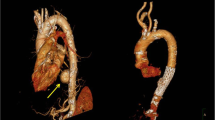Summary
BACKGROUND: This article reviews the mechanisms of thoracic aortic injury and therapeutic options for its repair. METHODS: We retrospectively analyze our data on surgery of the thoracic aorta for blunt trauma in 25 patients during the last two decades. RESULTS: Blunt aortic trauma is a rare but life-threatening incident, mainly resulting from deceleration forces in vehicle accidents and falls from a height. Dissection and rupture of the descending aorta distal to the left subclavian artery is the most frequently seen pathological correlate. Iatrogenic injuries resulting from cardiovascular surgery and endovascular interventions may also cause aortic trauma. Results of surgery in acute cases are less good than in a stable subacute or chronic phase (mortality, 20% vs. 0%). CONCLUSIONS: Traumatic injury to the thoracic aorta is a potentially lethal problem. When acute traumatic dissection or rupture of the thoracic aorta is diagnosed, surgical aortic repair must be performed immediately. In an unstable patient or if a contraindication for surgery exists, an endovascular stent graft prosthesis is a rational alternative. For acute aortic replacement, use of extracorporeal circulation is essential for organ protection and for a satisfactory surgical outcome.
Zusammenfassung
GRUNDLAGEN: Dieser Beitrag stellt Ursachen und Mechanismen thorakaler Aortenverletzungen und deren mögliche Behandlungsstrategien dar. METHODIK: Unsere Daten bezüglich stumpfer thorakaler Aortenverletzungen bei 25 Patienten der letzten zwei Dekaden werden retrospektiv analysiert. ERGEBNISSE: Ein stumpfes Trauma der thorakalen Hauptschlagader ist selten, jedoch lebensbedrohlich und resultiert zumeist aus Autounfällen oder Fall aus großer Höhe. Das am häufigsten gesehene pathologische Korrelat ist eine Dissektion und Ruptur der deszendierenden Aorta, distal des Abgangs der linken Armschlagader. Weitere Ursachen für Traumen der Aorta sind iatrogen, etwa nach kardiovaskulären Operationen oder interventionellen endovaskulären Eingriffen. Die Ergebnisse der Akutoperation nach stumpfem Aortentrauma sind weniger günstig als in der stabilen subakuten oder chronischen Phase (Mortalität, 20 % vs. 0 %). SCHLUSSFOLGERUNGEN: Die traumatische Verletzung der thorakalen Aorta stellt ein potentiell letales Problem dar. Wird eine akute traumatische Dissektion oder eine Ruptur der thorakalen Aorta diagnostiziert, muss unverzüglich die chirurgische Sanierung erfolgen. Bei instabilen Patienten oder wenn schwerwiegende Kontraindikationen bestehen, ist die Verwendung endovaskulärer Stent Grafts eine rationale Alternative. Für den akuten Aortenersatz ist die Anwendung der extrakorporalen Zirkulation zur Organprotektion und für ein zufriedenstellendes chirurgisches Ergebnis unverzichtbar.
Similar content being viewed by others
Author information
Authors and Affiliations
Corresponding author
Rights and permissions
About this article
Cite this article
Klima, U., Sommer, SP. & Haverich, A. Injury to the thoracic aorta. Eur Surg 36, 139–144 (2004). https://doi.org/10.1007/s10353-004-0067-6
Issue Date:
DOI: https://doi.org/10.1007/s10353-004-0067-6




